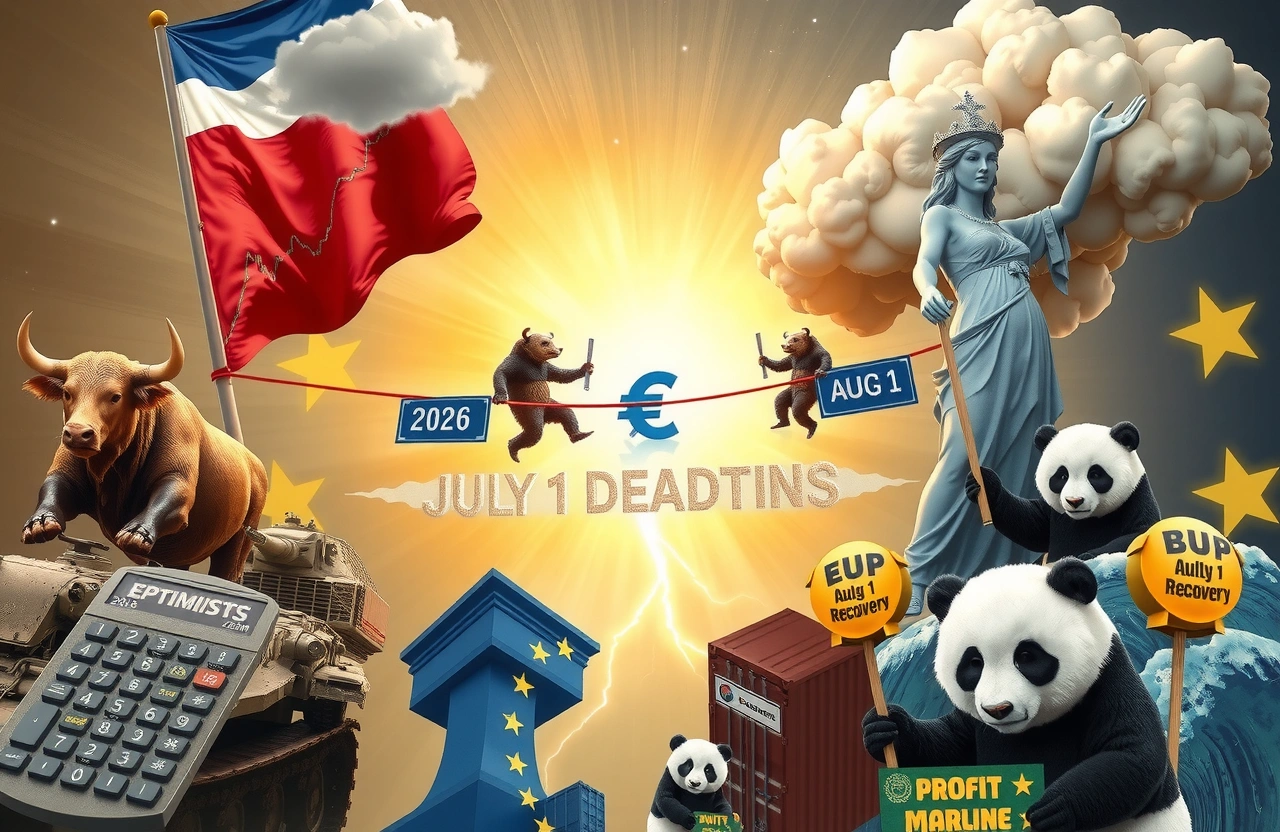The Crossroads of Europe’s Equity Surge
After a robust first-half recovery, European equities now face pivotal challenges. The Stoxx Europe 600 index has been range-bound in a narrow 3% band for nearly three months following its V-shaped rebound from April’s tariff-induced selloff. Market strategists surveyed by major financial outlets project mere 2% upside by year-end, reflecting widespread caution. The looming August 1 deadline for potential U.S. tariffs on EU exports and the euro’s 12% appreciation against the dollar form twin storm clouds hovering over corporate profitability.
Earnings Season Warning Signals
The Q2 reporting period has already revealed cracks in Europe’s corporate armor:
– Industrial giants BASF and Brenntag issuing profit warnings
– Renault’s disappointing automotive performance
– ASML’s semiconductor equipment sales below projections
Company executives universally cite tariff uncertainty and currency headwinds as primary concerns. French bank SocGen quantifies the currency impact: Every 10% dollar depreciation translates to approximately 4% erosion in European earnings.
The Tariff Tango: Brinkmanship Economics
Trump administration’s threat of 30% tariffs on EU goods effective August 1 creates unprecedented uncertainty. UBS strategist Sutanya Chedda describes the market’s current state as “a waiting game between cyclical optimism for 2026 and immediate trade/earnings realities.” Despite the tension clouding the European stock market outlook, some analysts see silver linings:
Priced-In Pessimism?
Citi strategist Beata Manthey notes: “European earnings forecasts already discount 20% U.S. tariffs – further downside might be limited.” Her team projects 5% index gains by December, anticipating 2026 earnings recovery to eventually lift valuations.
Currency Conundrum: The Silent Profit Killer
While tariffs dominate headlines, the euro’s strength constitutes an equally potent threat to the European stock market outlook. The 12% YTD currency appreciation creates structural disadvantages for exporters:
Quantifying Forex Impact
– Manufacturing competitiveness erosion in global markets
– Automatic dollar-income conversion penalties
– Embedded currency risk in forward guidance
Tourism-dependent economies like Spain and Greece face additional pressure as dollar-denominated travel becomes more expensive.
The Great Divide: Strategists vs Fund Managers
Analyst consensus reveals striking divergence from institutional positioning. Strategy desks project minimal upside, with bearish forecasts capping at 1.6% average declines. Meanwhile, Bank of America’s latest fund manager survey shows:
Institutional Optimism Prevails
– Net 41% of managers overweight European equities (4-year high)
– Net 37% expect near-term upside
– Net 81% bullish on 12-month horizon
The disparity stems from divergent interpretations of fiscal policy catalysts. Institutions particularly cite anticipated EU stimulus programs and German Chancellor Scholz’s defense/infrastructure spending initiatives.
Economic Resilience Beneath the Surface
Despite near-term headwinds, fundamental strengths fuel the European stock market outlook:
Embedded Advantages
– Economic surprise indicators near yearly highs
– German investor sentiment rebounds in ZEW July survey
– Corporate balance sheets with strongest cash positions since 2019
– Accommodative credit spreads supporting valuations
Frédéric Dodard, State Street’s EMEA portfolio chief, observes: “European firms have shock absorbers – healthy finances plus controlled rates buffer against moderate corrections.”
Sector Navigation Strategies
At this consolidation stage within the European stock market outlook, selective positioning becomes critical. Secondary beneficiaries present intriguing opportunities:
Opportunistic Allocation Strategies
– Domestic-focused consumer staples shielding against currency and tariff exposure
– Renewable energy infrastructure firms poised for capital spending acceleration
– Healthcare equipment makers benefiting from delayed recessionary cuts
– Defense contractors positioned for German expenditure commitments
Avoidance recommendations include exporters with high Americas revenue concentration and luxury goods manufacturers facing double pressure from currency shifts and potential tariff impacts.
Positioning for Probable Outcomes
Investors should implement multi-scenario hedges in their European equity allocations: Citi research suggests options strategies capturing currency rotations while Credit Agricole recommends pairs trades pairing domestic utilities against export-heavy industrials. The European Central Bank’s July policy meeting minutes reveal receptiveness to targeted interventions should tariffs materialize—a signal that policymakers stand ready to deploy shock absorbers. Market participants betting on resolution before August 1 face asymmetric risk reward but as JPMorgan quants warn: “Hope isn’t strategy in trade negotiations.”
The Verdict: Cautious Advancement
While technical indicators suggest consolidation potential extends through August, Europe’s relatively attractive valuations (12.8x forward earnings vs. 20.5x for S&P500) maintain structural appeal. Maintain European allocations at benchmark weights but pivot toward quality dividend stocks with pricing power and domestic orientation. Should tariff delays materialize or currency stabilize, cyclicals offer spring-loaded rebound potential. Regardless of political outcomes, dollar-cost averaging in multinationals capitalizing on EU recovery funds remains prudent.



